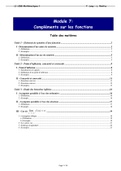Other
Mathématiques - Compléments sur les fonctions
- Course
- Institution
Ce document est un manuel de mathématiques portant sur le thème du calcul intégral. Il est organisé en trois unités. La première unité est consacrée aux primitives d'une fonction. Elle commence par une définition et des exemples, suivis de propriétés. Elle aborde également les primitive...
[Show more]



